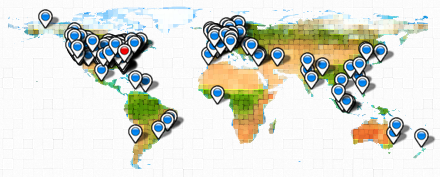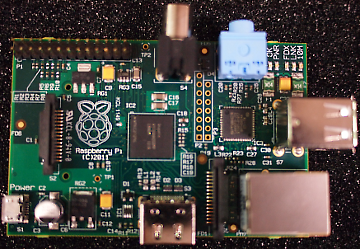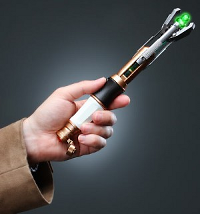What Looks Like a MacBook Air, But Isn’t?
This MacBook Air look-alike from China… it has a 1.8 gHz processor, and runs Windows, but looks pretty good, and it will sell for ~$240.00 US. What! Cool. Install Linux, rock on!
Dr. Bill | The Computer Curmudgeon
Join Dr. Bill as he examines the wild and wacky world of the web, computers, and all things geeky! Hot Tech Tips, Tech News, and Geek Culture are examined… with plenty of good humor as well!
This MacBook Air look-alike from China… it has a 1.8 gHz processor, and runs Windows, but looks pretty good, and it will sell for ~$240.00 US. What! Cool. Install Linux, rock on!
Podcast: Play in new window | Download (416.0MB) | Embed
Subscribe: RSS
Stupid User Tricks! Site clean-up, Linus Torvalds wins tech. equivalent of a Nobel Prize, real-life Doctor Who sonic screwdriver! Quadrotors! A credit card sized computer, where in the world? Han Solo in Carbonite chocolate bar, Firefly Geek Wisdom! Sponsor: GoToMeeting Conferencing with HD Faces: Simple Online Collaboration – https://bit.ly/xp4FFv
Links that pertain to this Netcast:
 |
|
 |
 |
| Download M4V | Download WebM | Download MP3 | Download Ogg |
Podcast: Play in new window | Download (Duration: 37:49 — 34.6MB) | Embed
Subscribe: RSS
Stupid User Tricks! Site clean-up, Linus Torvalds wins tech. equivalent of a Nobel Prize, real-life Doctor Who sonic screwdriver! Quadrotors! A credit card sized computer, where in the world? Han Solo in Carbonite chocolate bar, Firefly Geek Wisdom! Sponsor: GoToMeeting Conferencing with HD Faces: Simple Online Collaboration – https://bit.ly/xp4FFv
Links that pertain to this Netcast:
 |
|
 |
 |
| Download M4V | Download WebM | Download MP3 | Download Ogg |
 You have heard of “Where in the World is Carmen Sandiego?” Well, this is more like “Where in the world do they watch the Dr. Bill.TV show? Or, more to the point, where in the world have they come from to check out the web site!
You have heard of “Where in the World is Carmen Sandiego?” Well, this is more like “Where in the world do they watch the Dr. Bill.TV show? Or, more to the point, where in the world have they come from to check out the web site!
The Wibiya bar along the bottom of the screen on the site has an “Online” option… right on the bar, at the far left hand side… if you click it, you can see where people have come from to view the site… graphically! Cool! So, the whole world is watching! I will have to behave myself! Ahhh, no… guess not! (By the way, the red marker is your location… in my case, when I grabbed the screen shot, in High Point, NC!)
 Yep! A PC that you view via an HDMI connection for both Video and Audio, that is shown here, litterally almost actual size! And, it is only $35.00! Awesomeness!
Yep! A PC that you view via an HDMI connection for both Video and Audio, that is shown here, litterally almost actual size! And, it is only $35.00! Awesomeness!
“The Raspberry Pi is a credit-card sized computer that plugs into your TV and a keyboard. It’s a capable little PC which can be used for many of the things that your desktop PC does, like spreadsheets, word-processing and games. It also plays high-definition video. We want to see it being used by kids all over the world to learn programming.
Model A has been redesigned to have 256Mb RAM, one USB port and no Ethernet (network connection). Model B has 256Mb RAM, 2 USB port and an Ethernet port. The Raspberry Pi measures 85.60mm x 53.98mm x 17mm, with a little overlap for the SD card and connectors which project over the edges. It weighs 45g. The SoC is a Broadcom BCM2835. This contains an ARM1176JZFS, with floating point, running at 700Mhz, and a Videocore 4 GPU. The GPU is capable of BluRay quality playback, using H.264 at 40MBits/s. It has a fast 3D core accessed using the supplied OpenGL ES2.0 and OpenVG libraries.
The GPU provides Open GL ES 2.0, hardware-accelerated OpenVG, and 1080p30 H.264 high-profile decode.
The GPU is capable of 1Gpixel/s, 1.5Gtexel/s or 24 GFLOPs of general purpose compute and features a bunch of texture filtering and DMA infrastructure.
That is, graphics capabilities are roughly equivalent to Xbox 1 level of performance. Overall real world performance is something like a 300MHz Pentium 2, only with much, much swankier graphics.”
I want one to play with!!!
You HAVE to watch this cool video! Promise to watch the whole thing, though! It is AWESOME!
“Experiments performed with a team of nano quadrotors at the GRASP Lab, University of Pennsylvania. Vehicles developed by KMel Robotics.
About KMel Robotics: The company was founded in late 2011 by Alex Kushleyev and Daniel Mellinger (a native of High Point, NC!), graduates of the University of Pennsylvania. We are experts in hardware design and high-performance control and we focus on developing high-end research platforms for aerial and ground robotics and pushing the limits of experimental robotics. Our goal is to work closely with various institutions (including universities) and support their research work and other applications. The scope of support will include everything from the low-level hardware to complete systems, capable of autonomous operation.
 Doctor Who Sonic Screwdriver in real life! How EXTREMELY COOL is that?!?! I love it! Now, we just need a real K9! By the way, the picture at right is Doctor Who’s version NOT the “real life” one… just sayin’!
Doctor Who Sonic Screwdriver in real life! How EXTREMELY COOL is that?!?! I love it! Now, we just need a real K9! By the way, the picture at right is Doctor Who’s version NOT the “real life” one… just sayin’!
Real-life Doctor Who sonic screwdriver uses ultrasonic beams to perform medical procedures
“In Doctor Who the sonic screwdriver can do anything from picking a lock to tracking aliens, but researchers at the University of Dundee in Scotland are building a real-life version that could be used to perform a variety of medical procedures. The device uses an ultrasonic beam to move objects up and down, and the beam features a rotating structure — similar to a DNA helix, but with more strands — to spin them. In a demonstration the team managed to levitate and spin a small disk in a tub of water, but it’s more than just a magic trick.
‘Like Dr. Who’s own device, our sonic screwdriver is capable of much more than just spinning things around,’ explained Dr. Mike MacDonald. He says that the device has several potential applications in the medical field, including ‘non-invasive ultrasound surgery, targeted drug delivery, and ultrasonic manipulation of cells.’ The screwdriver is being funded by the Engineering and Physical Sciences Research Council — the same group behind the Cyberplasm — as part of a UK-wide project researching ultrasonic manipulation. You probably won’t see this technology in a hospital anytime soon, but we can guarantee you one thing — it won’t be much use in searching for extraterrestrial life.”
Our friend, Steven J. Vaughn-Nichols, with ZDnet, reports that Linus Torvalds, creator of Linux, is winning the equivalent of a Nobel Prize in Geekdom! I’m down wit’ dat!
Linus Torvalds wins the tech. equivalent of a Nobel Prize: the Millennium Technology Prize.
“You can win Nobel prizes for physics, chemistry, and medicine, but technology? No. There is, however the Millennium Technology Prize. This is the world’s largest technology prize. It is rewarded ever two years for a technological innovation that significantly improves the quality of human life, today and in the future. This year, Linus Torvalds, Linux’s creator, and Dr. Shinya Yamanaka, maker of a new way to create stem cells without the use of embryonic stem cells, are both laureates for the 2012 Millennium Technology Prize.
This prize, which is determined by the Technology Academy of Finland, is one of the world’s largest such prizes with candidates sought from across the world and from all fields of technology. The two innovators will share over a million Euros. The final winner will be announced by the President of the Republic of Finland in a special ceremony on June 13, 2012.”
I just finished a HUGE clean-up of previously dead links, and old info in ALL my old podcast/netcast postings from episode 1 all the way through 235, here on the blog! Wow! That was painful! BUT, the good news is that now when you go to look for ALL our video netcasts, they are there, as they should be, at this link:
https://www.drbill.tv/category/dr-bill-netcasts/
And, all our audio netcasts are at this link:
https://www.drbill.tv/category/dr-bill-audio/
So, that is good, I think I will go now and have a little lie down (to quote Hitchhiker’s Guide!)
There are a lot of clueless people in the world, and sometimes, their ignorance can be VERY entertaining!
Are You Kidding Me? Strangest Helpdesk Requests
“‘Can you help me fix my toilet?’ Believe it or not, the person who asked this question was calling his company’s IT help desk, not the plumber. This is just one of the unusual requests CIOs said they or their support staff have received, according to a new Robert Half Technology survey.
These types of inquiries aren’t all that bizarre for help desk professionals, and they demonstrate it often takes patience as well as technical know-how to assist colleagues at work.
The survey was developed by Robert Half Technology, a provider of IT professionals on a project and full-time basis. It was conducted by an independent research firm and is based on telephone interviews with more than 1,400 CIOs from companies across the United States with 100 or more employees.
CIOs were asked, ‘What is the strangest or most unusual request you or a member of your help desk or technical support team has ever received?’
Their responses included:
Help desk professionals are known for lending a hand even if a request falls outside their job description, but these employees took the concept too far:
Help desk professionals are willing to answer just about any technical question, but some end users may want to enroll in a ‘Computer 101’ course:
‘Beyond their entertainment value, these unusual requests demonstrate the strong customer service skills necessary to work in the help desk and technical support fields,’ said John Reed, executive director of Robert Half Technology. ‘The best IT professionals are composed and empathetic — and, of course, have a good sense of humor.'”